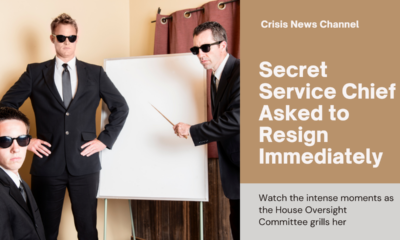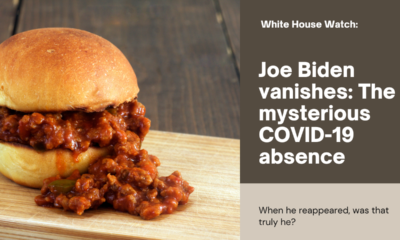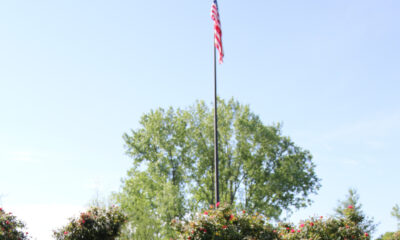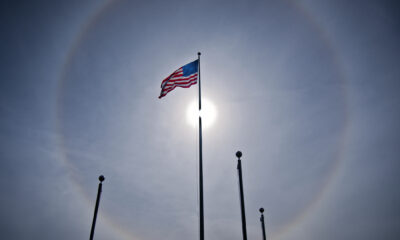Constitution
Censorship case – respondents’ brief
The respondents in Murthy v. Missouri, the big censorship case, filed their brief with the Supreme Court. But they’re missing crucial support.
The apparent lead plaintiffs – therefore lead respondents – in the great censorship case filed their response today before the Supreme Court. Murthy v. Missouri, docket no. 23-411. In their brief, they laid out all the harms the government has wrought on the body politic, and the user bases of various social-media platforms, at least since the start of the Biden administration. (Note that Donald J. Trump does not appear as a defendant.) In their brief, the respondents lay all the blame on the government for the censorship they have endured. Ironically the only defense the government has, is that any of these platforms had a perfect right to do the one thing the government evidently would never have tolerated. Which is to say, they could have said, “No!” As several platforms have done – and suffered for it.
Full history of the censorship case
This case began originally as Missouri v. Biden, case no. 3:22-cv-01213. The Attorneys General of Missouri and Louisiana filed it in Monroe, La., on May 5, 2022. (See CourtListener’s docket listings at the District Court and Appeals Court levels. See also two Supreme Court docket listings, for the application for stay, and for a petition for review.)
Then-Attorneys General Eric Schmitt of Missouri (now Senator), and Jeff Landry of Louisiana (now Governor) filed the case originally. Since then, many private plaintiffs have joined the case, through amendment of the complaint and through consolidation. The most recent Amendment Complaint is the Third, filed May 5, 2023 – the anniversary of the original Complaint. Joining the two Attorneys General were:
- Three physicians who had lost their posting privileges on Twitter (now X) over their statements contradicting the COVID-19 Narrative, and
- The Editor-in-Chief of The Gateway Pundit, and one of his colleagues, over their coverage of those moderational actions.
Since then, Robert F. Kennedy, Jr., and Children’s Health Defense won consolidation of their own case with the Missouri case.
The Gateway Pundit published its 62-page brief before the Supreme Court had a chance to publish it on their site. In order to guard against erasure, they uploaded it to the Wayback Machine, which accepts more than snapshot URLs. They are also hosting it on their own site and making it available for download.
Emphasis of the respondents’ brief
The respondents feel the need to emphasize the coercive nature of the government’s conduct. For that reason they repeatedly connect censorship decisions to threatening statements and cajolery from the following agencies:
- The White House, the
- Office of the Surgeon General, the
- Centers for Disease Control and Prevention (CDC), the
- Federal Bureau of Investigation (FBI), and the
- Cybersecurity and Infrastructure Security Agency (CISA).
In each case, the respondents have the text of the orders that went to the platforms’ Trust and Safety Teams. Many of these orders had a rich detail that positively screams “long-term relationship.”
Respondents also refer to a technique they call “switchboarding,” and accuse CISA of this. To switchboard means to gather or solicit complaints from other agencies and forward these to platform moderators for action.
CISA especially represented targeted posts as indicating foreign influence. Respondents deny that flatly and say that “domestic speech” was the clear target. (The FBI allegedly does the same.) Topics that drew the government’s attention – and ire – include without limitation:
- The Hunter Biden Laptop story,
- Coronavirus incidence, prevalence, and case-fatality,
- Coronavirus vaccine safety and efficacy, and
- Election integrity, specifically as regards the Election of 2020.
Censorship by coercion – or by conspiracy?
The brief makes one statement suggesting that the platforms’ hands might be dirty:
Defendants are also engaged in joint action with platforms. Even if platforms are not coerced, federal officials conspire with platforms through endless private meetings and communications reflecting extensive, direct federal involvement in specific decisions. Defendants are also pervasively entwined in platforms’ moderation policies and enforcement practices, as they have insinuated themselves to become deeply embedded in both the strategy and minutiae of silencing disfavored viewpoints.
This goes to the long-term relationship mentioned above. But the defendant-petitioners will argue the difference between coercion and persuasion. Persuasion – even conspiracy – does not exactly satisfy the Knight Test that Justice Clarence Thomas outlined in April of 2021. To review:
[A]lthough a “private entity is not ordinarily constrained by the First Amendment,” Halleck, 587 U.S., at ___, ___ (slip op., at 6, 9), it is if the government coerces or induces it to take action the government itself would not be permitted to do, such as censor expression of a lawful viewpoint. Ibid. Consider government threats. “People do not lightly disregard public officers’ thinly veiled threats to institute criminal proceedings against them if they do not come around.” Bantam Books, Inc. v. Sullivan, 372 U.S. 58, 68 (1963). The government cannot accomplish through threats of adverse government action what the Constitution prohibits it from doing directly. See ibid.; Blum v. Yaretsky, 457 U.S. 991, 1004–1005 (1982). Under this doctrine, plaintiffs might have colorable claims against a digital platform if it took adverse action against them in response to government threats.
In that light, allegations of conspiracy come close to a fact asserted for the first time at the review level. The Supreme Court doesn’t ordinarily consider evidence not adduced at trial or even at intermediate appeal.
But the most salient weakness of this case thus far is the lack of any briefs from platforms that:
- Refused any such orders from, or even any such relationships with, the government, and then:
- Suffered significant and demonstrable economic consequences as a direct result.
At least three platforms qualify here: Gab, Parler, and Rumble. Parler continued to offer a platform to President Trump, after Twitter (now X) banned him. Suddenly Amazon Web Services, their hosts, de-hosted them. Eventually they came back – but that was only temporary. Last April, a company called Starboard bought the platform – and shut it down forever.
Gab and Rumble vowed to fight – and are still fighting
Gab has a different story. Host after host de-hosted them, on one pretext or another. One host accused them of hosting pornography. Actually, off-color images of scantily clad women did appear on Gab. Your editor simply blocked the accounts involved. But that was only an excuse. (Since resolving their issues, Gab now expressly forbids pornography of any degree, because they have an ideological aversion to it.) Not only did hosts refuse to host them, but both major smartphone “app stores” disallowed their dedicated apps. Today the only way to access Gab on any hardware is through a browser, with or without a shortcut. But a user can do this – and your editor does it all the time. More to the point, Gab literally built its own server farm and sold one-time premium passes to finance this.
Rumble has struggled mightily to achieve the reach of its major competitor, YouTube. But, like Gab, they have their own server farm.
Both platforms have occasionally received orders to “take down” posts or videos. And both have definitely refused. They pride themselves not only in refusing but in putting themselves into a position to refuse. (The respective content standards of Gab and Rumble are each simplicity itself. YouTube’s Community Guidelines fill a book. Rumble’s and Gab’s could each fit on a single 8½ by 11 sheet.
Shared ideology
So why didn’t Meta (Facebook and Instagram), Twitter, or especially Alphabet (Google and YouTube) do the same? Did the platform owners simply not want to spend the money? Or did they in fact persuade themselves to cooperate with a government with whom they shared an ideology? Gab and Rumble most emphatically do not share the ideology of the Biden administration, the European Union, the World Economic Forum, or the United Nations and its subsidiary organizations. They have spent the money on their own infrastructure, so they refuse to obey their orders. Sometimes they have blocked direct access to their servers from the territories of foreign governments who gave censorship orders. They can do this because every “Internet libertarian” has heard of a wonderful new invention called a Virtual Private Network. This allows absolutely anyone to access any domain in any territory – by proxy.
So the Supreme Court will have to ask itself whether the building of separate, independent infrastructure was a reasonable burden to assume, given that Gab and Rumble assumed that burden. That Gab and Rumble have never “briefed” any Court is a glaring weakness. Why haven’t they? Andrew Torba, head of Gab, has said up-front why: he wants to poach Meta’s, X’s, and Alphabet’s users. “Stop complaining to the courts and come to us!” he says in effect to those users. “We built our castles, and surrounded each with battlements and moat! We withstood the siege, we have consistently defied the censors, and we always will!”
The government’s censorship case is weaker still
The government’s case is perhaps weaker, because they have no excuse for what they did. If the factual allegations by respondents are accurate – and one has no reason to believe they lie – then the government suppressed truth, so often that one could no longer tell truth from falsehood in what the government itself said. Indeed the respondents emphasize truth in their complaint.
Censorship presents two problems:
- How dare the government restrict the dissemination of truth? And:
- How does one know that what the government says is a lie, truly is a lie?
The government can at any time charge someone directly with any of a number of “lying offenses.” Fraud – lying for a direct and dishonest gain – is the obvious such offense. So are libel (in print), slander (out of print), and defamation of character – categories of spiteful lying. This government has vilified the plaintiffs, or those whose rights the plaintiffs are tasked to guard, in many ways. Why did the government never charge anyone with fraud? Possibly because they knew such a charge would never “stick.”
In contrast, no public official can charge the “spiteful lie” offenses. The First Amendment leaves “public figures” no recourse, unless someone accuses them of common garden-variety felonies they did not commit. That leaves the kind of pressure the government brought to bear. But again, unsympathetic social-platform moderators consistently refuse to stifle such criticism of public figures. We’re back to Gab and Rumble building their own infrastructure, and refusing to obey.
The private-company defense
Yet here again, the government now must assert, as a defense, that private companies are free to do that which the government would never have wanted. But what would have happened if Meta, Twitter, and Alphabet had taken the same attitude Gab and Rumble now take? Then Donald Trump would have known better than to commission the coronavirus vaccines. The expansion of mail-in ballots would never have occurred. And Trump would not only have had access to far better advice in the hiring of Attorneys General, Surgeons General, and similar officers, but also – and most important! – he could have undertaken his planned prosecution of the Deep State far earlier. But they didn’t, and he didn’t, and it did, and he didn’t, and he couldn’t – and here we are.
Conclusion
In 1962, Stanley Milgram, Ph.D., demonstrated that people will obey even the most outrageous orders, if they believe they do so in a good cause. That applies equally to social-media platform owners and moderators as to individuals taking part in experiments in “the effect of punishment on memory.” CNAV is not prepared to state positively whether Milgram’s Obedience study strengthens the case for the respondents – or the petitioners.
Clarence Thomas wanted his test case against government censorship by proxy. He got it, though how it came to the Court is messier than he wished. (See his colleague Sam Alito’s dissent from the decision to stay the Big Injunction.)
Count on Thomas, Alito, and their colleage Neil Gorsuch – the Originalist Bloc – to side with the respondents. But! Count on Ketanji Brown Jackson, Elena Kagan, and Sonia Sotomayor to side with the petitioners. That leaves Chief Justice John Roberts and Justices Amy Coney Barrett and Brett Kavanaugh. If Justice Barrett, out of misplaced concern for “panic in the streets” or “millions dead” votes with the petitioners, so will Roberts, as they did in the recent Texas border dispute case. Then Andrew Torba – and Dan Bongino at Rumble – will shout out, “There! You see?” And maybe we’ll see a Great Realignment of social media.
Terry A. Hurlbut has been a student of politics, philosophy, and science for more than 35 years. He is a graduate of Yale College and has served as a physician-level laboratory administrator in a 250-bed community hospital. He also is a serious student of the Bible, is conversant in its two primary original languages, and has followed the creation-science movement closely since 1993.
-

 Executive4 days ago
Executive4 days agoSecret Service chief gets no solace
-

 Executive3 days ago
Executive3 days agoWaste of the Day: Louisville Taxpayers Pay Nearly $600,000 For Empty Building’s Maintenance, Security
-

 Guest Columns4 days ago
Guest Columns4 days agoFear Itself: Democrats’ Favorite Strategy Caused Their Current Chaos
-

 Executive3 days ago
Executive3 days agoWhere is Joe Biden – or Jill?
-

 Executive1 day ago
Executive1 day agoWaste of the Day: Throwback Thursday: Cities Used Crime Prevention Funds on Soccer Games, Paper Shredding
-

 Executive2 days ago
Executive2 days agoFacile and politically motivated suggestions
-

 Civilization4 days ago
Civilization4 days agoBuild Iron Dome in the United States To Prepare for Israel’s Worst Day
-

 Executive4 days ago
Executive4 days agoThe Emerging GOP Plan To Beat Kamala Harris












